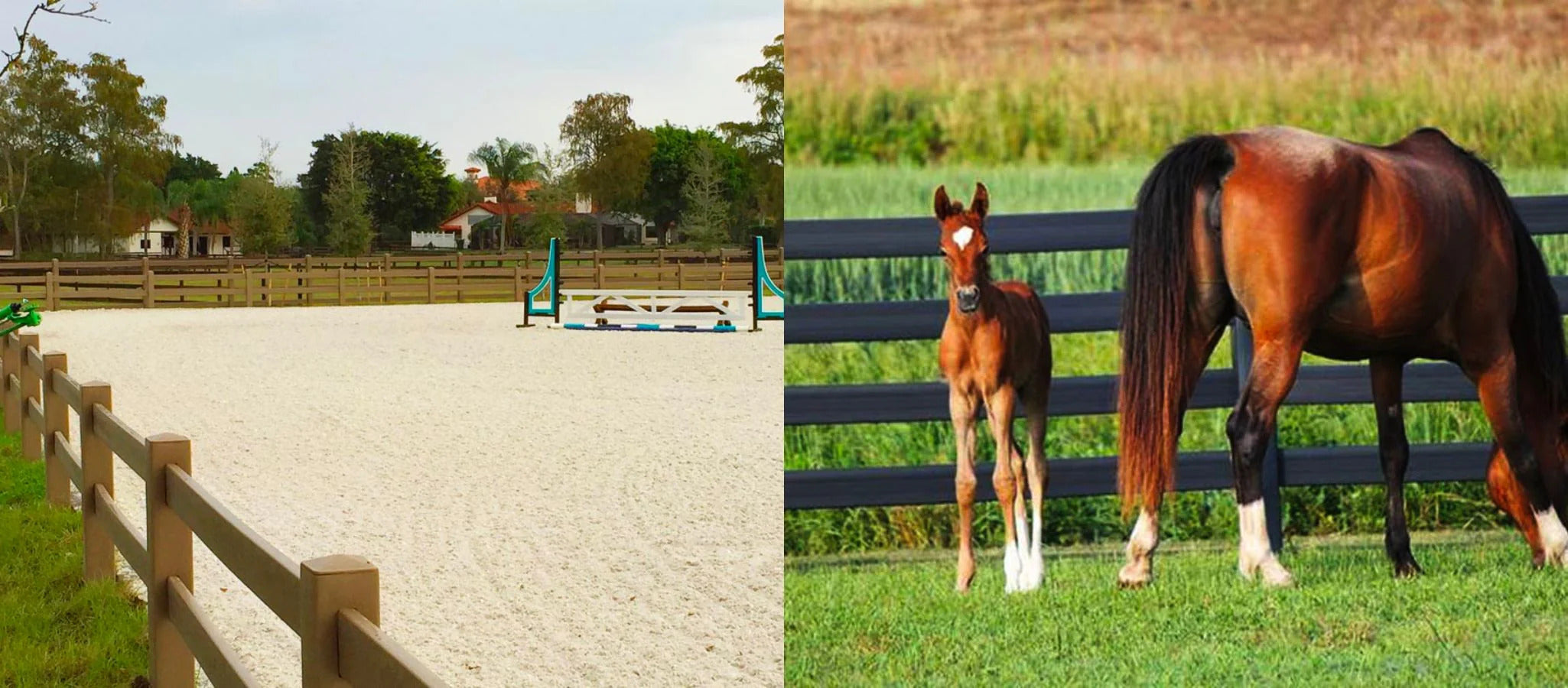While we might be known for our luxury barn products such as horse stalls and barn doors, we also offer a premium fencing option to our clients. When it comes to horse fencing for your farm, there are so many options to choose from. Options can include everything from steel-based fencing to PVC fencing to HDPE fencing to your traditional wood post fencing. As you can tell, the available options are almost as diverse as the amount of horse breeds out there!
At American Stalls, we offer two types of fencing products to our clients. The first being steel-based post and rail fencing. The second is our HDPE fencing. In this article, we would like to cover the in's and out's of our HDPE fencing because it is an option that we recommend to virtually every client.
About American HDPE Fencing:
To begin, our American HDPE Fencing is 100% made in the USA just like our custom stabling equipment. Our Fencing utilizes 2' x 6' rails that are manufactured like typical lumber sizes. The construction difference between our HDPE is that American HDPE Fencing is hollow. This makes it lighter and easier to work with than traditional wood fencing. Our HDPE rail weighs about as much as a wooden rail of the same dimensions. However, our post weighs about 25% as much as solid wood of the same dimensions.
Each rail is then supported and stiffened by two internal reinforcing ribs that lock into place in a 6'x6' post. This double reinforcement rib construction delivers ultimate strength upon impact. They are locked in place with our galvanized locking buttons that safely retain the rails into the post. One key benefit though is that this system allows for the easy removal of the rails when you might need access for tractors and other farm equipment.
Rails & Use Cases:
Our American HDPE Fencing is available in 2, 3, 4, and 5 rail configurations. Our diverse offerings allow clients the needed flexibility for their various fence applications. Our two-rail HDPE horse fence is the perfect fit for dressage arenas and also entryways in driveways. This system allows ample visibility to deter horses and livestock from crossing and suddenly appearing in front of a vehicle.
Our three-rail HDPE horse fence is especially well suited for for paddocks, corrals, farm perimeter, dry lots and riding arena fencing. We recommend a rule of thumb to clients which is to have the top of the top rail equal to or greater than the horse’s withers. If you use our three-rail HDPE horse fence as premeter fencing, we do recommend to consider a hot wire addition. This is not because the horses could ever break all the way through the HDPE, but it is to give you, the horse owner, the 100% assurance that your fencing will stay in tact. This will also depend largely from horse to horse as some horses are very well-mannered. 
Our four-rail HDPE horse fence is fantastic for specialized applications such as a foaling barn. The four-rail system can prevent a foal from rolling under the bottom rail and can also be used for stallion containment. We are able to offer clients the options to even go up to five or six rails when needed for containment.
Colors & Maintenance:
As mentioned above, our HDPE Fencing has the ability to be fully customizable for your farm's needs. Similar to our luxury horse stalls, our HDPE Fencing is built with three core elements in mind: elegance, safety, and longevity. We offer our fencing in 8 stunning colors to complement the look you achieve in your American Stalls barn project. These colors include white, black, weathered wood, hunter green, and so much more.
Additionally, our fencing is 100% HDPE. Unlike other HDPE fences and PVC fences on the market, our HDPE does not contain any toxic chemicals such as arsenic or chlorides. As a result, it will not contaminate your water or soil. This guarantees that your fencing is strong, durable, aesthetically stunning, easy to clean, stain resistance, virtually maintenance free for years. Our HDPE material will not shatter or split – even in extremely cold climates. It is tested that our American HDPE Fencing can withstand temperatures as low as -60 degrees Fahrenheit. Lastly, each of our fencing systems is backed by our industry-leading 20 year warranty. Rest assured, your American HDPE Fencing will serve you for decades to come.
HDPE Fencing vs PVC Fencing:
PVC Fencing is a popular option chosen by many equestrians for his general popularity and its cost-effective price point. However, we strongly recommend clients against PVC fencing. The below photo demonstrates what can happen to fences made from PVC (or Vinyl). The primary issue is that PVC-Vinyl fencing becomes brittle in cold weather. Additionally, it doesn’t fair very well in warm temperatures upon impact either.
This is because PVC-Vinyl fencing was designed to be used as decorative fencing as opposed to livestock containment. We recommend our HDPE Fencing because PVC-built fencing is not safe to contain animals as PVC can cause a serious or even fatal injury. In contrast, our HDPE Fencing is designed and engineering to be primarily used for equine containment. We manufacture our fencing with high density polyethylene (HDPE) that uses thick wall construction and double-rib interior construction. This ensures that it will absorb impact of a full extended leg kick from any horse breed.
Do you have more questions regarding our American HDPE Fencing? We are here to help you every step of the way! Please feel free to give our team a call at (855) 957- 8255, email us at sales@americanstalls.com to schedule a sales and design consultation. We look forward to helping you with your future horse stalls and horse fencing project.





